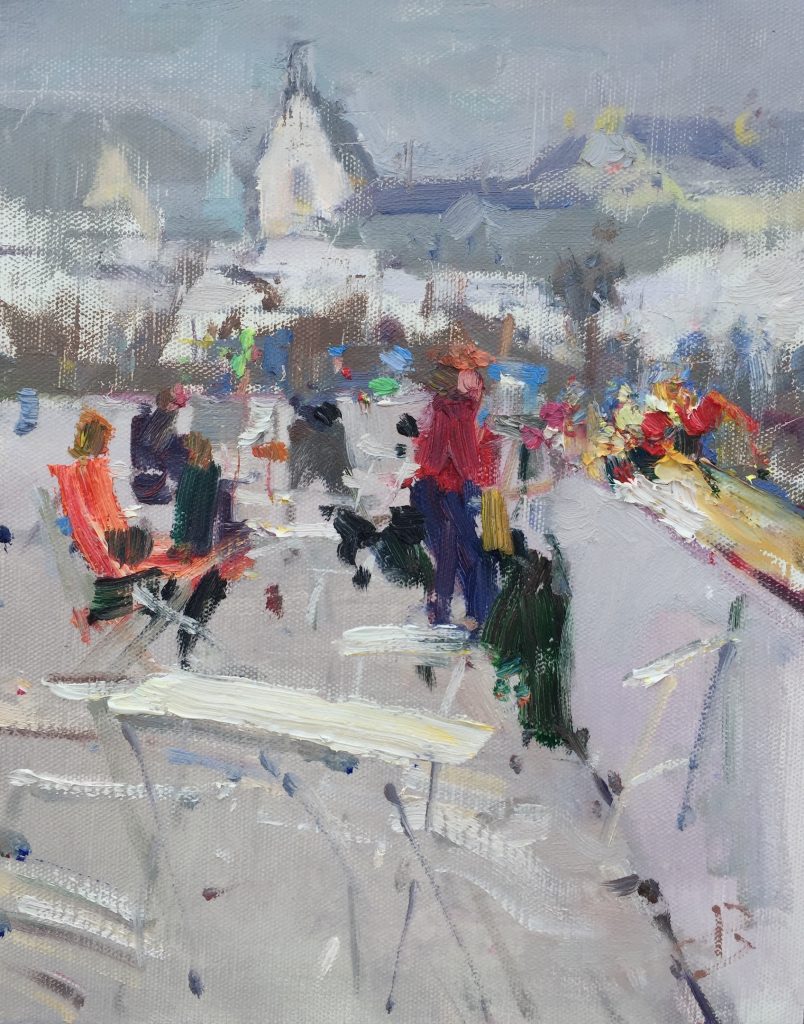
In order to get inspiration for painting above scene, I just started copying the shapes of the buildings in the background, and then played around with the shapes and colors of the people in the foreground. The end result was an abstract painting, but based on the reality of Kilmore Quay, the little fishing village where I was painting in Ireland.
If you are having problems figuring out how to get inspiration for painting, this quote by Chuck Close says it all:
“Amateurs look for inspiration, the rest of us just get up and go to work.” – Chuck Close
Using play to get inspiration for painting
Painting isn’t something that you have to plan in advance. You can treat it more like play in which you experiment with the paint, or whatever artistic medium you have to hand. As you play, ideas will develop and start to form in your head. The shapes and colors you put down will suggest things to you as you play—it then becomes a question of how to direct that play. You can then develop those ideas, and gradually they will transform into something artistic, based on your intuitive sense of what feels good, and what doesn’t.
The importance of truth in art
The key is to get started. Let nature be your guide. In other words, just paint anything you see around you, or that catches your attention in some way.
The first thing to understand is that painting is about finding the truth in your subject, and then just conveying that truth. You can ignore everything else that doesn’t add to this truth. The implications of this are that you should start by trying to capture something accurately, whether it is a shape, a line, or a color relationship. This is what will give your work truth, and result eventually in a good painting.
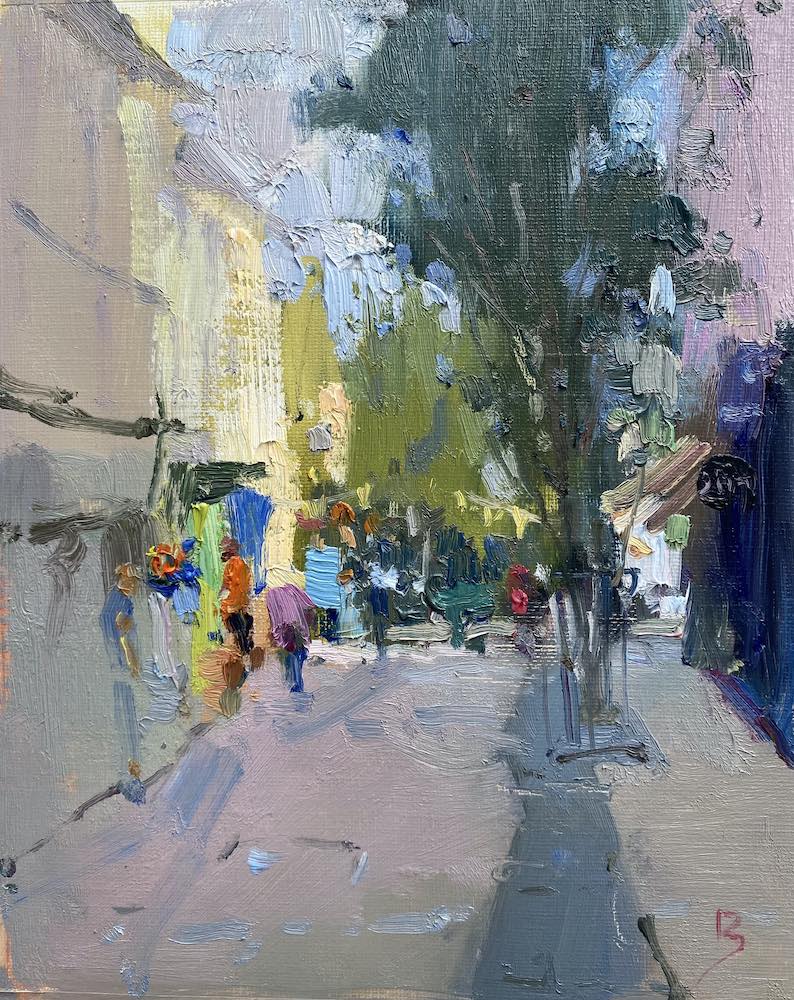
The truth I found in this painting was the relationship of the grays in the buildings on the street. Each house was gray, but with a tendency to a particular hue. All of the grays were less saturated than the people on the street and the goods outside the shops. That was the truth of the scene.
How to get inspiration for painting – step 1
Often, when I don’t know what to paint, I will just get my drawing book out, and start copying a scene or landscape in front of me. I try to capture it as accurately as I can. This helps me observe what I am looking at in a much deeper way. All of a sudden I get inspiration for painting something that appeals to me.
I start noticing little details, like the way the peaks of the mountains always seem to be the same type of triangle, or how a river gradually becomes narrower and narrower in the distance, or how one type of tree I am drawing is always as wide as it is high, but the other type of tree is always twice as high as it is wide.
These are all visual truths. It is these things that will communicate the essence of the landscape to the people looking at my painting. If you don’t start by trying to copy these things accurately, you will never find the truth, and so never be able to communicate a truth to the viewer.
How to get inspiration for painting – step 2
Go back to the drawing. Now I am starting to notice much more about the visual nature of what I am focusing on. I now start to see the triangles repeating, and creating some kind of pattern. I see the same repeating patterns in the rectangular shapes in the trees.
Then I stop copying what I see. I start to play. I’ll start another sketch on a different piece of paper and play around with the triangles, arranging them in an interesting pattern. I’ll do the same for the rectangular shapes of the trees. I’ll do one pattern, and see if I like it.
I’ve now moved away from copying to playing around with shapes, but I am retaining some of the truths of nature. I am not discarding the proportions of the height to width of the trees, or the angles in the mountain peaks.
Multiple tries
Often I don’t get inspiration for painting something interesting on my first try. So I just try another pattern. Eventually, often after several attempts, I find an arrangement of things that are interesting. At that point, I can start to develop my drawing, distributing the shapes, creating patterns, and organizing the shapes around some kind of framework.
A word of caution—the fallacy of ‘just express yourself’
I know many artists say just express yourself, and your feeling will just come out magically somehow. I don’t believe that. I believe you have to do some work first. After all, painting is just visual communication. Think of poetry as an analogy. If you never learned how words were spelled, and had only learned the letters of the alphabet, and then your tried to express your ideas by writing letters at random on a page, would your ideas be communicated? Would beautiful poetry come out as a result?
So why should visual communication be any different? You need to be able to copy shapes accurately in order to create accurate representations of nature. Then you will be able to express your ideas about nature. That is why learning to draw is so important.
Tip: it is not as difficult as you think to learn how to draw. I have never come across anyone, who, given the right method, couldn’t learn how to draw reasonably well in about a week. So don’t let that put you off.
Expanding your artistic horizons
Another way to get inspiration for painting is simply to look at a lot of great art. A lot of great art however is not necessarily well known. Sometimes a new teacher, who is knowledgeable in painting can introduce you to new artists.
Conversely, a lot of well known art is not necessarily great art. Other artists are not well known, but nevertheless are really great artists. For example, most people have heard of the French Impressionists, but relatively few people have heard of the Russian Impressionists, who produced, to my mind, many equally good paintings. The Russian Impressionists were masters at handling grays, and contrasting warm and cool temperature differences.
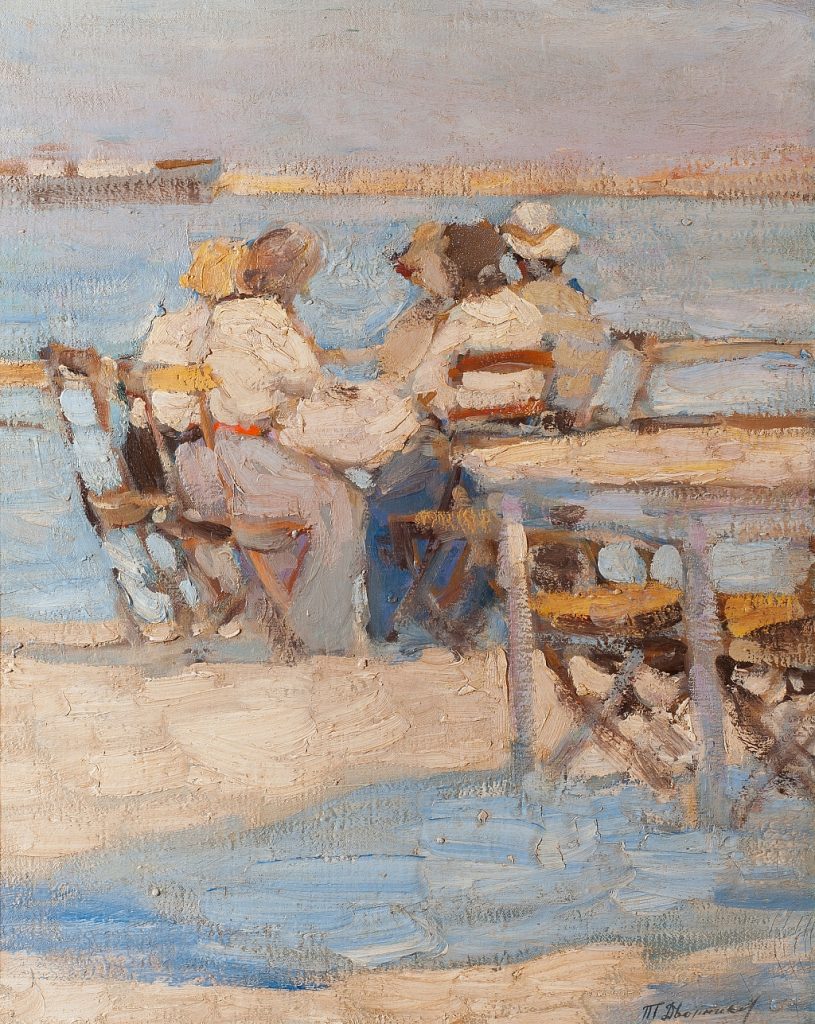
The Russian Impressionists were masters at handling grays, and contrasting warm and cool temperature differences. This can give you inspiration for your own art.
Visiting museums
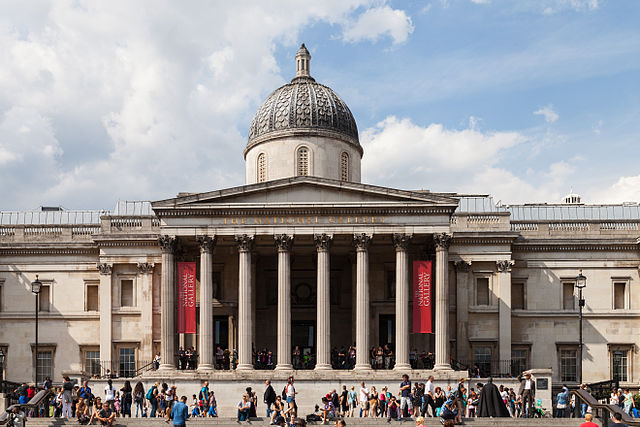
Looking at old and contemporary master paintings in museums, galleries, and online, will help you get inspiration for your own art.
When you visit a museum, it is a good idea to take opportunity of special exhibitions that focus on just one, or two, artists, and that explore their work in more detail.
This way you get to learn about their struggle, and how they developed their artistic ideas. You can also often see how they approached the same subject from different angles, which can also give you new ideas, as well as some inspiration for tackling a subject in which you are interested, but in a different way from the way you had been tackling it before.
Here is a video of me visiting the Petit Palais in Paris, and explaining how various master artists created organizational structures in their paintings.
Multi-cultural art
There are many genres of art, both in terms of art from different time periods, as well as art from different parts of the world. You can get more ideas, and potentially get inspiration for painting, by broadening your viewpoint and exposing yourself to a wider variety of art.
For example, the art of Japan inspired Monet. In this genre of artwork, how the space on the canvas is divided is particularly important. The Japanese were masters at dividing space on a canvas and on designing shapes. This might give you some inspiration for your own art, and suggest different ways of approaching it.
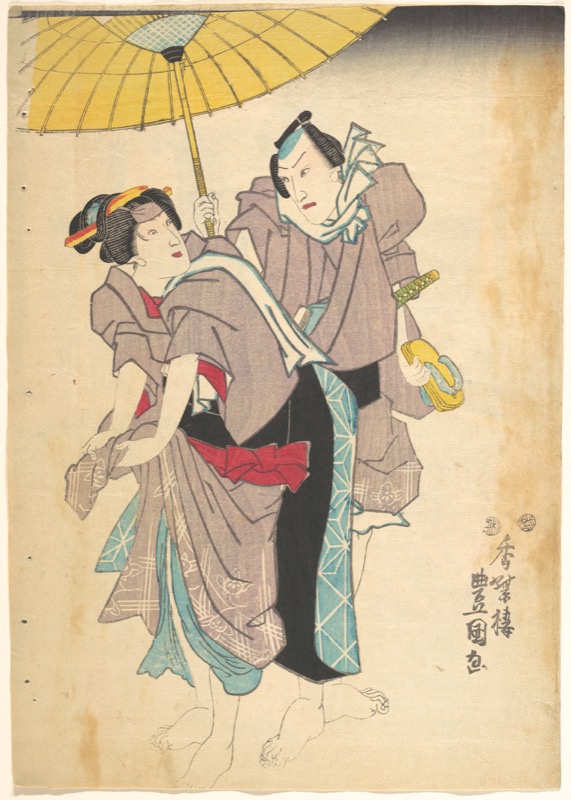
The Japanese were masters at dividing space on a canvas and on designing shapes
How To Get Inspiration For Painting — Other Ideas
Here are some other ideas for how to get inspiration for painting if you need to renew your enthusiasm.
Try new media
For example, if you are used to using oils or acrylics, try watercolor, or vice versa. Each media has different properties that can expand your ideas of how to handle the media. I was trained in watercolors, and even though I prefer to paint in oils now, I sometimes use techniques that I learned from my training in watercolors.
Learn a new technique
Related to the previous idea, another idea for how to get inspiration for painting is to learn a new technique in your chosen media, by perhaps taking a workshop with a different artist. Always remember to separate out technique from principles. The underlying principles of painting (those things I include in my Apprentice Program), are universal truths and will always apply. Techniques however, are infinitely varied, and you can use whatever technique you want, within the bounds of the underlying principles of painting.
Try new subject matter
It is very easy to get into a rut, by painting the same subject matter. If you change subject matter, you might find you gain new inspiration for your painting. For example, if you always paint still lifes, try landscape painting for a change, or vice versa. If you always paint flowers, try painting man-made objects for a change.
Working with other artists
If you work with other artists, sometimes you will find yourself painting things you would otherwise not have considered. This can force you to look harder to find beauty in things, and increase your powers of observation.
Another advantage is you might both be painting the same subject matter, but you will find that you will approach the subject in totally different ways. Seeing the same subject matter from two completely different perspectives can be quite liberating.
Travel to a new place
Just by changing the scenery and traveling to a new place is another solution for how to get inspiration for painting. For example, I often travel to different parts of the world, seeing new places and new people. I always get inspiration for painting by looking at the totally different subject matter, as it forces you to make designs out of different shapes, and to find harmonies in different color palettes.
For example, in the painting below, I had to learn a whole new palette to capture the light and vibrant reds of Morocco. In 1832, Eugène Delacroix similarly explored the light of Morocco in a 6-month trip, in which he found inspiration in the people, their clothing, the landscape, and the architecture he found there.
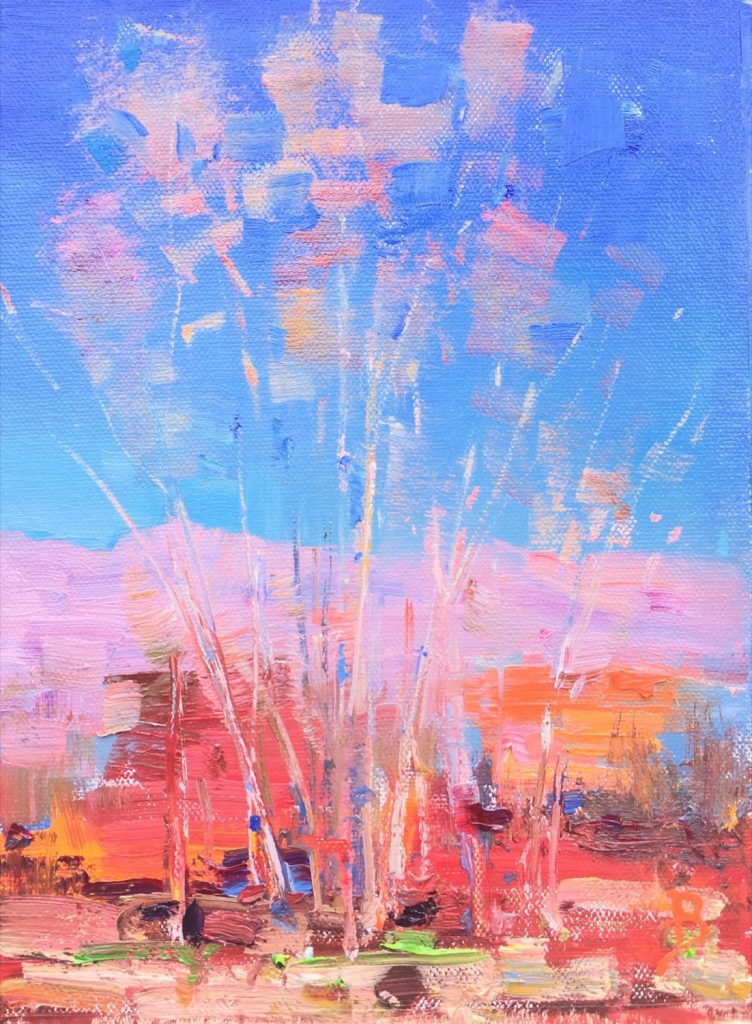
I had to learn a whole new palette to capture the light and vibrant reds of Morocco
I hope you found these ideas for how to get inspiration for painting useful, and that it will help get you motivated to pick up the brush and paint. Let me know your own ideas for how you get inspiration for painting in the comments below.
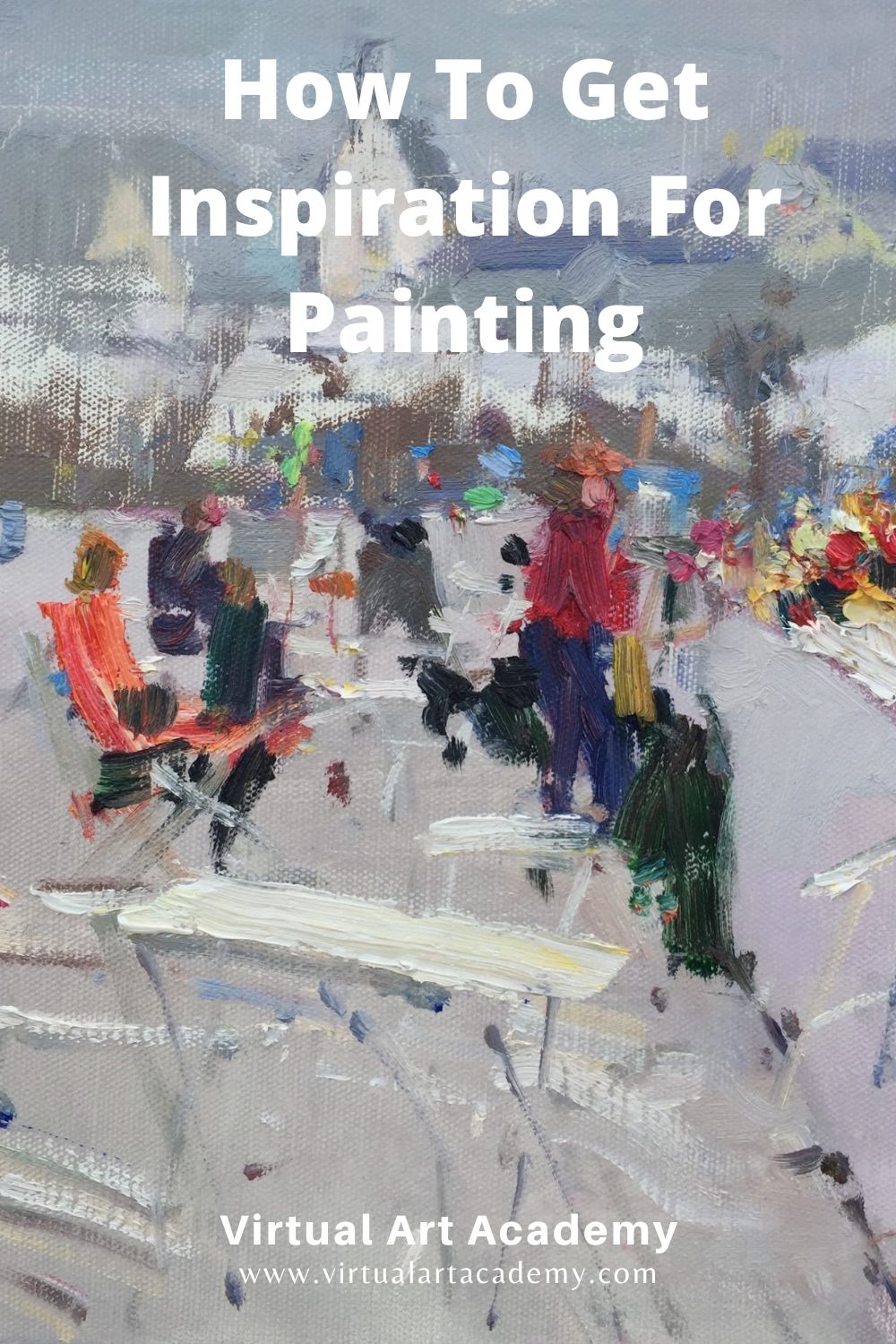
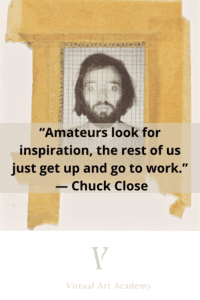
Thank you Barry for this article. I find myself at a strange juncture of not being able to get started again with my painting. I’ve taken many classes the past years. Your program looks inviting but I don’t know where to jump in. Can I give you my website where you could look at what I have done and give me some advice?
Yes, of course. Send it with a note on the contact page on this website, and I will be happy to take a look.
The usual problem is that the classes you took did not break the problem down into small enough chunks of knowledge, combined with a exploratory ‘play’ approach to building the skill, and so you got confused and didn’t develop the underlying skill you needed. You have to build up skills in small steps, one at a time, and integrate this learning with lots of experimentation and practice. The goal is to get the stage of letting intuition take over while painting, and not to think too much while painting. Keep painting and learning separated.
The analogy is that you don’t learn to build a cathedral by watching someone build one. You first learn stonework, sculpture, woodwork, glasswork, design, structural engineering etc. This is the fundamental problems with watching art videos of someone doing a painting. Trying to learn by watching someone paint is setting yourself up for frustration and failure in my opinion. If you have been learning by watching video demonstrations of people painting, this might be the source of your blockage.
I hope that helps.
Barry
Thank you for this article. I’ve taken hundreds of photos and driven many miles looking for the perfect inspiration, when what I really need to do is just get to work! My sister always says “ Just sit down and paint!” As I growl under my breath and say “But you don’t understand! it’s not that simple!”. Wow, lightbulb moment. It just hit me that maybe in feeling insecure about my abilities, I have subconsciously hoped the perfect scene would, in a sense, do the work for me. In the book “Making Color Sing”, Jeanne Dobie tells of hosting a workshop where she told her students to go find whatever they wanted to paint. They all went outside looking for the perfect inspiration, while she chose to paint an old refrigerator in a back room which made a lovely painting. This was a good lesson to me, but I needed to be reminded. Thank you.
Thanks so much for this. I’ve been in the painting doldrums for several years now, because I was waiting for inspiration. The comment about just getting to work rather than waiting for inspiration hit home for me. The other comment about not just painting what you feel, but applying skills was also very useful.
This meant so much to me. Thank you!